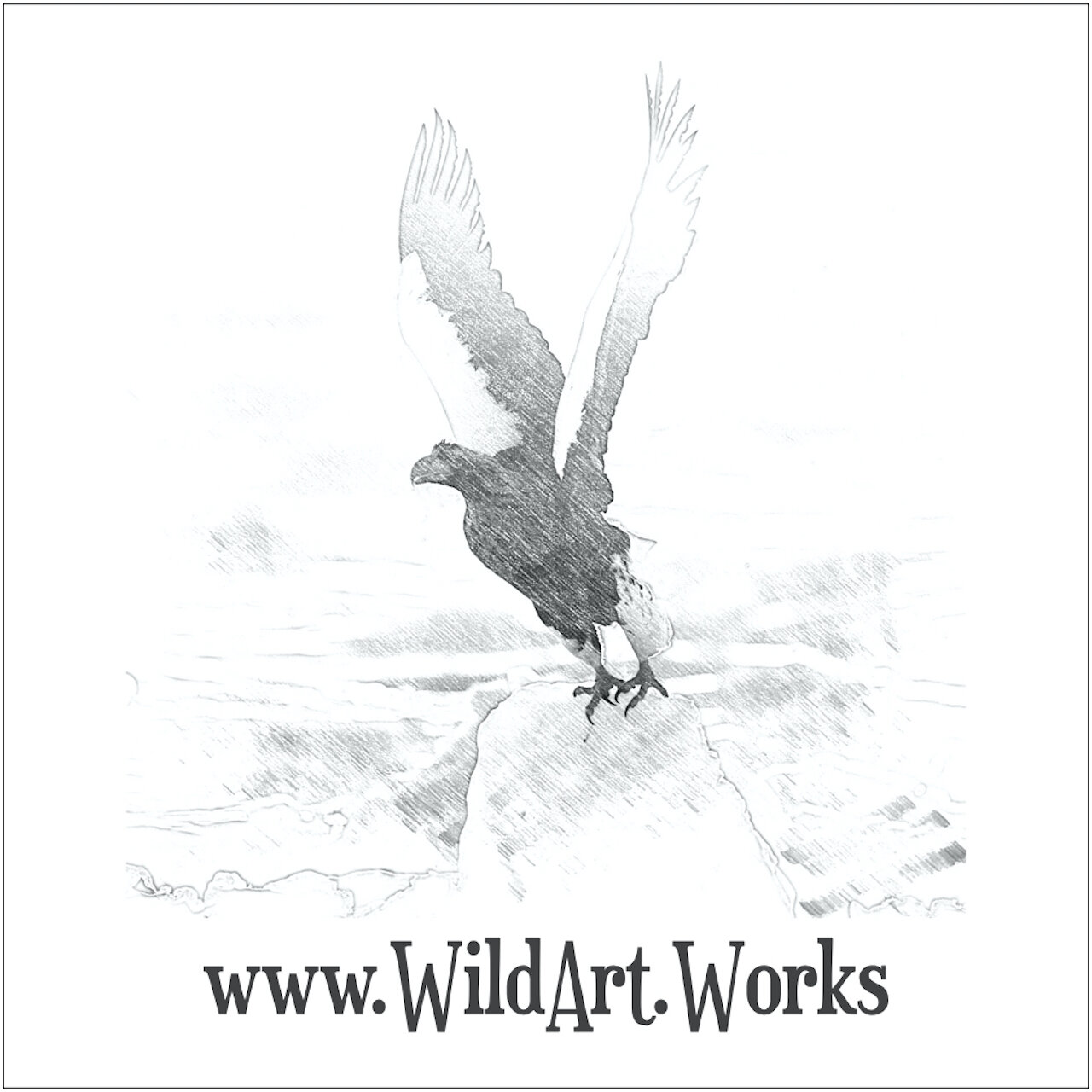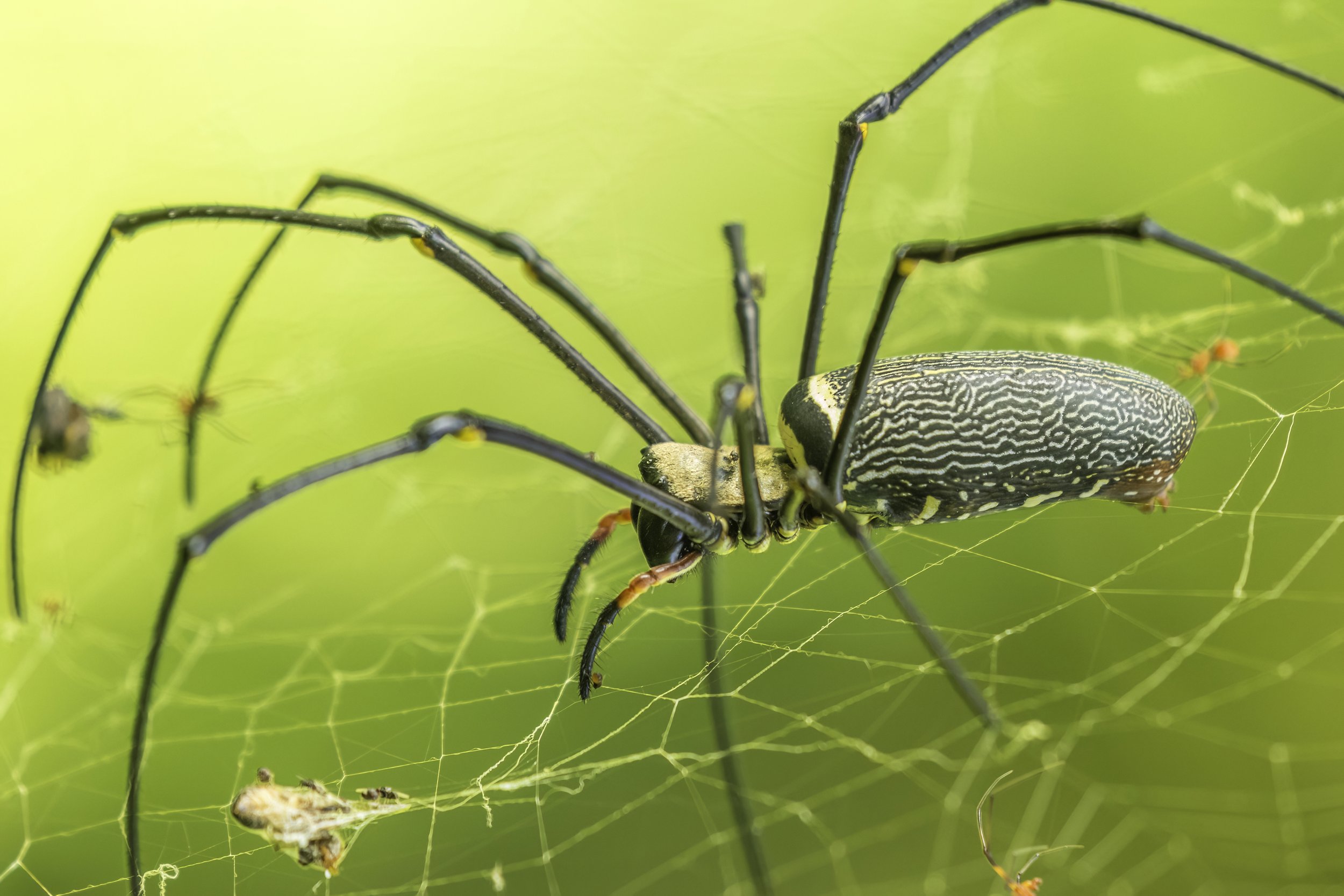Behind the Lens
a blog every Friday on a specific species of animal or bird and stories of photos
Search for a specific species, genre or even a location or use the directory for a complete list of species I have photographed and written about till date.
Listen to my TEDx talk.
Giant Golden Orb Weaver/ Giant Wood Spider
Nephila is a genus of araneomorph spiders noted for the impressive webs they weave. Nephila consists of numerous species found in warmer regions around the world, although some species formerly included in the genus have been moved to Trichonephila. The name Giant Wood Spider is used to refer mainly to Nephila pilipes, which is very often seen, owing to its size and needless to say the size of its web. This is a common spider in the jungles of peninsular India, where webs built across large open spaces (and at times spanning up to 2 meters) are not uncommon. They are also called the Giant Golden Orb Weaver. Often, the webs of all these Golden Orb Weavers are inhabited by kleptoparasites. As a group, they also exhibit extreme male dwarfism and female gigantism.
#wildartworks, #Canon, #Wildlife, #naturephotography, #earthcapture, #earthpix, #naturyst, #conservationphotography, #yesbbcearth, #indian_wildlifes, #indianwildlifeofficial, #wildlifeonearth, #bbcearth, #natgeowild, #natgeoindia, @globalcapture, #giantwoodspider, #goldenorbweaver, #giantgoldenorbweaver, #nephilapilipes, #nephila, #spider, #woodspider, #goldensilkorbweavers, #goldenorbweavers, #giantwoodspiders, #banana spiders,
Bay-backed Shrike
The Bay-backed Shrike is a brightly-colored small shrike, reminiscent of the Long-tailed Shrike in overall coloration. It has a black mask, rufous flanks & back, a clean white throat, and its small size makes it distinctive within its range. It prefers open areas, often in dry regions, with scattered vegetation. Often perches up on exposed snags, fenceposts, or telephone lines.
#wildartworks, #Canon, #Bird, #Birdinginthewild, #BirdWatching, #Wildlife, #WildBirds, #naturephotography, #your_best_birds, #planetbirds, #earthcapture, #photo_pond, #earthpix, #naturyst, #conservationphotography, #yesbbcearth, #indian_wildlifes, #indianwildlifeofficial, #wildlifeonearth, #bbcearth, #natgeowild, #natgeoindia, @globalcapture, #TelanganaBirds, #HyderabadBirds, #Tellapur, #GHMCUrbanForestryNursery, #TelanganaUrbanForestry, #Nallagandla, #baybackedshrike, #shrike
Red-naped Ibis
A medium-sized ibis with a dark body, often showing a bluish-green sheen. The crown and nape are covered in bright red warts. A white patch is usually visible near the shoulder of the wing. The bill is long and downcurved. This species can be confused with the similar-looking Glossy Ibis, but Glossy Ibis is smaller and lacks the red warts and white shoulder patch. In flight, the legs of Red-naped Ibis don’t extend beyond the tail, unlike in Glossy Ibis. Unlike most other ibis, Red-naped favors drier habitats, such as rye fields. It is usually found singly or in loose groups.
#wildartworks, #Canon, #Bird, #Birdinginthewild, #BirdWatching, #Wildlife, #conservationphotography, #bhigwan, #BhigwanBirdSanctuary, #Kumbhargaon, #ujnibackwaters, #Tadoba, #kabini, #rednapedibis, #ibis,
Blue-tailed Bee-eater
The blue-tailed bee-eater (Merops philippinus) is a near passerine bird in the bee-eater family Meropidae. It is widely distributed across South and Southeast Asia where many populations are strongly migratory, and seen seasonally in many parts but breeding colonially in small areas across their range, mostly in river valleys, where they nest by tunnelling into loamy sand banks. They are seen mostly in open habitats close to water.
#wildartworks, #Canon, #Bird, #Birdinginthewild, #BirdWatching, #Wildlife, #WildBirds, #naturephotography, #your_best_birds, #planetbirds, #earthcapture, #photo_pond, #earthpix, #naturyst, #conservationphotography, #yesbbcearth, #indian_wildlifes, #indianwildlifeofficial, #wildlifeonearth, #bbcearth, #natgeowild, #natgeoindia, @globalcapture, #bluetailedbeeeater, #beeeater, #TelanganaBirds, #ammavaripetacheruvu, #ammavaripeta, #warangalbirding, #loronghalus, #singaporebirds, #singaporebirding,
Brown-headed Gull
The brown-headed gull is a small gull breeding in the high plateaus of central Asia from Tajikistan to Ordos in Inner Mongolia. It is migratory, wintering on the coasts & large inland lakes of the Indian Subcontinent. Its pale button eyes give it a somewhat fearsome appearance. The breeding adult’s head is the color of milk chocolate, lightening towards the bill. Non-breeding & first-winter birds have a dark ear patch and faint traces of the dark hood. All plumages may be confused with the smaller Black-headed Gull, but note the pale eyes and more extensive black on the primaries in all plumages. Breeds on high-altitude lakes on the Tibetan Plateau and winters on marshes, estuaries, lakes and rivers, most often in coastal areas.
#wildartworks, #Canon, #Bird, #Birdinginthewild, #BirdWatching, #Wildlife, #conservationphotography, #bhigwan, #BhigwanBirdSanctuary, #Kumbhargaon, #ujnibackwaters, #brownheadedgull, #seagull, #gull,
Black-naped Oriole
The black-naped oriole is a passerine bird in the oriole family that is found in many parts of Asia. A typical yellow and black Old World oriole, the male is entirely golden-yellow apart from black wings & tail and a broad black band through the eyes. The tail and wings have yellow tips and the bill is deep pinkish. The female is similar to the male but with more yellowish-green upperparts. Juveniles show streaked underparts. They are found in a variety of forest habitats, including plantations and gardens; foraging in the forest canopy. There are several distinctive populations within the wide distribution range of this species and in the past the slender-billed oriole was included as a subspecies.
#wildartworks, #canon, #Birdsinwild, #BirdWatching, #Wildlife, #WildBirds, #naturephotography, #exclusivewildlife, #natgeoindia, #conservationphotography, #indian_wildlifes, #indianwildlifeofficial, #wildlifeonearth, #planet_untamed_magazine, #bbcearth, #natgeowild, #sungeibuloh, #bishanangmokiopark, #indianbirds, #bedokreservoir, #blacknapedoriole, #oriole,
Slaty-backed Gull
The slaty-backed gull is a large, white-headed, thickset, short-winged, pot-bellied gull that breeds on the north-eastern coast of the Palearctic, but travels widely during non-breeding seasons. It is similar in appearance to the western gull and the glaucous-winged gull. Often looks rather frosty by the first winter; starts to develop a gray back and whitish eye in its second year. Primarily an Asian species, found in coastal regions from Japan and South Korea to Russia. Regularly occurs in western Alaska, but very rare elsewhere in North America.
Subscribe if you would like to continue reading the stories.
#wildartworks, #Canon, #PromediagearTR424L, #Bird, #Birdsinwild, #BirdWatching, #Wildlife, #WildBirds, #naturephotography, #exclusivewildlife, #planetbirds, #earthcapture, #wildlifeseekers, #earthpix, #naturyst, #conservationphotography, #Hokkaido, #wildlifeonearth, #bbcearth, #natgeowild, #slatybackedgull, #gull,
Asian Koel
The Asian Koel is a large shy bird, distinctive in all plumages, usually secretive, keeping to the interior of dense trees in many habitats belonging to the cuckoo order of birds, the Cuculiformes. It is found in the Indian Subcontinent, China & Southeast Asia. It forms a superspecies with the closely related black-billed koels, and Pacific koels which are sometimes treated as subspecies. This is a bird without borders, frequently heard but rarely seen.
#wildartworks #canon #Wildlife #wildlifephotography #telanganabirds #natgeoindia #conservationphotography #indian_wildlifes #indianwildlifeofficial #wildlifeonearth #planet_untamed_magazine #bbcearth #natgeowild #birdsofthedeccan #hyderabadbirds #lakesofhyderabad #ameenpur, #biodiversityheritagesite, #HyderabadBiodiversity, #heritagesite, #ameenpurlake, #ancientmanmadelake, #manmadelake, #asiankoel, #koel, #manjeera, #sungeibuloh, #ranganathittubirdsanctuary, #bhigwanbirdsanctuary, #bishanangmokiopark, #chincholi, #chandrampally, #indianbirds,










